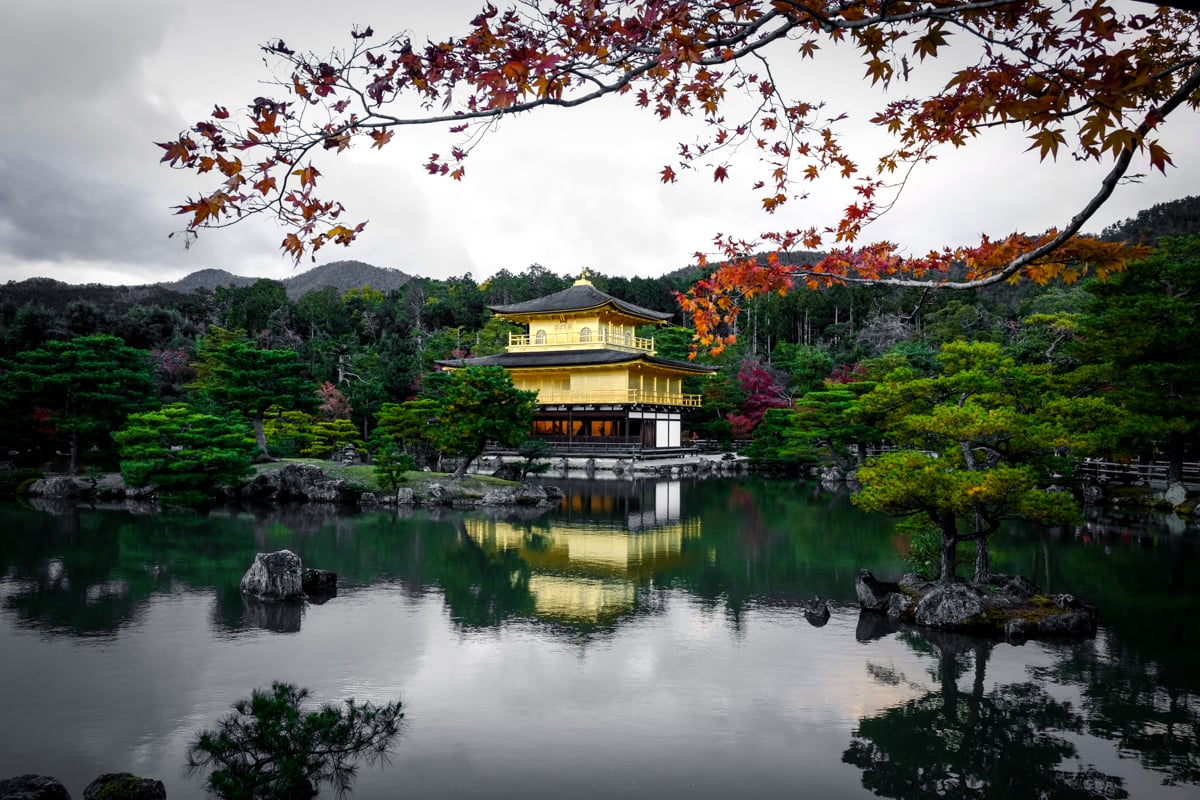Summary
After a series of visits to Japan over the years, I’ve compiled this Kyoto temple & shrine guide to assist you in discovering the best ones! Kyoto, recognized as Japan’s ancient capital and cultural heart, boasts numerous famous shrines and temples that are must-see attractions.
With more than 2,000 temples and shrines in Kyoto, choosing which ones to visit may pose a challenge. Continue reading for my comprehensive Kyoto temple guide!
Where To Stay In Kyoto




Best Traditional Shrines & Temples In Kyoto Japan
1. Kinkaku-ji Temple
The Kinkaku-ji Temple, or Golden Pavilion, is one of the most iconic and beloved locations in Japan. As the most visited temple in Kyoto, it is easy to understand why! With its stunning architecture and surroundings, capturing breathtaking photographs is virtually guaranteed.
To enjoy a serene visit, consider going in the morning when the winds are light, allowing for beautiful reflections on the pond. However, during our visit, the wind was strong, which limited the reflections.
Read More: Kinkakuji Temple
2. Ginkaku-ji Temple
After visiting the Golden Pavilion, consider exploring its lesser-known counterpart, Ginkaku-ji, also known as the Silver Pavilion. Nestled in eastern Kyoto (Higashiyama), this temple is easy to reach.
Originally constructed in the 15th century as a mountain retreat for the shoguns, Ginkaku-ji features a striking dry sand garden and a raised cone that resembles Mount Fuji.
3. Tenryu-ji Temple
Built in the 14th century, Tenryu-ji Temple rests in Kyoto’s Arashiyama district. Notable for its picturesque landscape garden, it becomes particularly vibrant with autumn colors around mid-November.
Moreover, the temple shares its borders with the famous Arashiyama Bamboo Grove, making it a convenient stop while visiting popular tourist attractions in west Kyoto.
4. Fushimi Inari Shrine
This 8th-century shrine features over 1,000 vibrant orange torii gates surrounded by lush forest. Wandering through the maze of gates is a captivating experience, complemented by several scenic mountain trails.
However, be mindful that this location attracts large crowds of tourists, so scheduling your visit during early morning or late afternoon is advisable.

5. Kiyomizu-dera Temple
Renowned as Japan’s most celebrated temple, Kiyomizu-dera is an exceptional site for experiencing autumn foliage. While the main building typically captures the attention of visitors, our favorite feature was the stunning orange pagoda beside it.
Constructed in eastern Kyoto during the 8th century, Kiyomizu-dera offers an abundance of photogenic opportunities throughout its grounds.
6. Yasaka Pagoda
No visit to the Higashiyama district is complete without encountering this iconic pagoda that rises prominently above the surrounding buildings. Although the Yasaka Pagoda, built in the 15th century, is part of a temple that dates back to the 6th century, its historical significance is notable.
The best photographic prospects are from the exterior, but visitors can also ascend to the second floor of the pagoda for a fee.

7. Kennin-ji Temple
During our stroll through the Higashiyama area, we unexpectedly encountered Kennin-ji Temple. While initially unaware of its cultural importance, we later discovered it is recognized as one of the most significant Zen temples in Kyoto, with a foundation dating back to 1202 AD.
Its striking black and white aesthetics provide an appealing backdrop for photographs.

8. Byodo-in Temple (Uji)
This temple, often overlooked by travelers, is situated in Uji, a quaint city between Kyoto and Nara, making it a convenient day trip option. Originally constructed in the 11th century, Byodo-in Temple is even featured on the Japanese 10 yen coin.
An intriguing fact is that Byodo-in Temple has a twin building in Hawaii that closely resembles it and shares the same name!

9. Todai-ji Temple (Nara)
Todai-ji Temple is among Japan’s most monumental and spectacular landmarks. While it is located just outside of Kyoto, it remains easily accessible for visitors from the city. This incredible historic site was once the world’s largest wooden building for a millennium and houses the largest bronze Buddha statue globally.
Having visited Todai-ji numerous times, I can confidently state it’s a must-see. While exploring Nara Park, you’ll also discover several other traditional Japanese temples and shrines. Nara is an easy addition to your itinerary, making it a fantastic day trip from either Kyoto or Osaka.

Kyoto Temple Map
Utilize this Kyoto temple map to plan your trip effectively. By clicking on icons, you can access additional information and directions for each location. Please note some locations on this map may be approximate.
For more detailed information about reaching specific Kyoto temples featured on this map, consider viewing my individual travel guides for each site.
Japanese Temple Etiquette
While most traditional shrines and temples in Kyoto welcome tourists, there are essential rules to follow:
- Maintain a calm and respectful demeanor, avoiding noise, especially indoors.
- In some temples, you’ll need to remove your shoes before entering. This may involve leaving them at the entrance or using provided plastic bags.
- Photography is generally permitted on the temple grounds, but usually not inside buildings; restrictions will be clearly posted.
- While many Kyoto temples and shrines are free, some charge an entrance fee, typically below 500 Yen ($5 USD), valid for the entire day.
- Kimono rentals are available throughout Kyoto. Wearing traditional dress is usually welcomed for photographs, and many locals enjoy seeing visitors in their attire.
Best Time To Visit
Kyoto’s temples and shrines are particularly enchanting during autumn and cherry blossom seasons, albeit crowded. These seasons vary each year, generally occurring during the last week of March for sakura (cherry blossoms) and peaking around mid-November for autumn colors in Kyoto.
For the best experience, it’s advisable to visit early in the morning or late in the afternoon, as midday crowds can be overwhelming, especially during holidays and peak times.
At temples with ponds, such as Kinkakuji, visiting early allows for capturing stunning reflections before winds disturb the surface.
Kyoto Hotels
Best Tours In Kyoto Japan
Thank you for exploring this guide! I hope you found this list of some of the best temples to visit in Kyoto, Japan, informative and enjoyable.





